|
 |
|
| Table of contents |  |
|
|
|
 |
|
 |
| |
Installation:
Setting up:
In action:
Tools:
Other:
| |
|
 |
|
| Where can I buy the full version of TopAreaCodes? |  |
|
|
|
 |
|
 |
| |
|
RNS:: TopAreaCodes is now freeware. You can simply download the full version from here.
| |
|
 |
|
| Supported devices |  |
|
|
|
 |
|
 |
| |
|
RNS:: TopAreaCodes was designed exclusively for Treo 600, Treo 650, Treo 680, Treo 700p, Treo 755p, and Palm Centro smartphones. It will not run on any other devices.
| |
|
 |
|
| What files should I install? |  |
|
|
|
 |
|
 |
| |
You must install the tac.prc file which is the main program file, as well as some databases that contain resources for various areas: area names, maps, flags, etc. TopAreaCodes is unable to display any information on the area code unless you install at least one resource database.
The most important databases are included in the ZIP and SIT packages together with the main program file. You may download other databases later on.
| |
|
 |
|
| Where should I put the files? |  |
|
|
|
 |
|
 |
| |
- The main program file (tac.prc) must be installed in the main memory RAM.
- Resource databases containing texts (e.g. country names) must also be put in RAM.
- Resource databases containing graphics (e.g. maps, flags) may be installed either in RAM or on an expansion card.
Databases on the card must be placed in the default directory for .prc files, which is /PALM/Launcher by default. Using HotSync guarantees their proper placement in RAM or on the card.
| |
|
 |
|
| Why so many databases? |  |
|
|
|
 |
|
 |
| |
If TopAreaCodes was a single file:
- It would be very large - a few megabytes.
- Low resolution Treo device users (Treo 600) and high resolution Treo device users would have both: lowres and hires versions of resources.
- You would have no choice between normal and high-quality resources.
- Everyone would have to have all resources installed... if you're not from Mozambique, do you really need to know all areas, flags, maps and seals in Mozambique? Obviously not.
Now you can install a really small program file (TopAreaCodes is less than 100K) and download only those databases you really need.
Databases may contain:
- area names, e.g. "Germany", "Japan", "California", "Texas".
- area maps, examples:
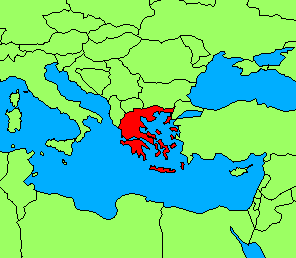 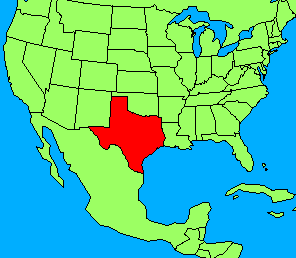
- area flags, examples:
   
   
- area seals (coats of arms), examples:
| |
|
 |
|
| Downloading additional databases |  |
|
|
|
 |
|
 |
| |
There are lots of resource databases available on the Internet. They contain various information on various areas. All resource databases are free. They can be downloaded:
- From the official TopAreaCodes Databases web site.
- Using the Tools=>Download Databases... menu command in the TopAreaCodes setup screen. A Treo device friendly web site will be opened in your web browser.
| |
|
 |
|
| First steps |  |
|
|
|
 |
|
 |
| |
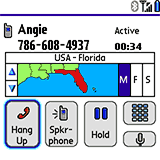 So you have RNS:: TopAreaCodes and a few resource databases installed. In fact you can immediately call someone or ask to be called, to see TopAreaCodes in action. Both in the Incoming Call screen and in the Active Call screen you will see the appropriate content from the resource databases you have installed. You may see the area name (a country, a state) of your caller, the flag of that area, area map or seal. So you have RNS:: TopAreaCodes and a few resource databases installed. In fact you can immediately call someone or ask to be called, to see TopAreaCodes in action. Both in the Incoming Call screen and in the Active Call screen you will see the appropriate content from the resource databases you have installed. You may see the area name (a country, a state) of your caller, the flag of that area, area map or seal.
Note, however, that there are lots of configuration options available after launching TopAreaCodes. Read on:
| |
|
 |
|
| The main setup screen |  |
|
|
|
 |
|
 |
| |
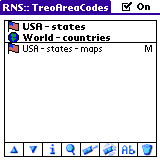 Go to your applications launcher and tap the TopAreaCodes' icon
Go to your applications launcher and tap the TopAreaCodes' icon  . The main setup screen of TopAreaCodes will show up. It is used for managing resource databases, as well as launching additional TopAreaCodes tools (like Find Area by Code or Find Code by Area). . The main setup screen of TopAreaCodes will show up. It is used for managing resource databases, as well as launching additional TopAreaCodes tools (like Find Area by Code or Find Code by Area).
The screenshot on the right shows TopAreaCodes with 3 resource databases installed:
- USA - states is a text database. It contains names of the American states, e.g. "California", "Florida", "Massachusetts".
- World - countries is a text database, too. It contains names like "Japan", "Mexico", "Poland".
- USA - states - maps is a graphical database containing a map of the USA with individual states highlighted.
Text databases are always placed at the top of the list and are marked with bold font. Disabled databases are grayed out. Databases placed on the expansion card are marked with the  symbol. References to missing card databases are marked with the symbol. References to missing card databases are marked with the  symbol. symbol.
You can see the general activation switch On in the top-right corner. Use it to temporarily disable TopAreaCodes.
Read on:
| |
|
 |
|
| Buttons on the main setup screen |  |
|
|
|
 |
|
 |
| |
There are 8 buttons at the bottom of the main setup screen. They are used to manage installed resource databases:

- 1, 2 - Priority - changes the priority of graphical databases. The databases placed at the top will be displayed initially during a phone call. So if you want to be presented a map first, move all map databases to the top.
- 3 - Info - shows information on the selected database and lets you disable it temporarily with the Enabled switch. Disabled databases do not show up during a phone call.
- 4 - Browse - shows contents of the selected database: area codes together with relative information: names, flags, maps, etc.
- 5 - Beam - beams the selected database.
- 6 - Send - sends the selected database (e.g. via Bluetooth).
- 7 - Rename - changes the description of the selected database.
- 8 - Delete - removes the selected database from RAM and expansion card.
| |
|
 |
|
| Display preferences |  |
|
|
|
 |
|
 |
| |
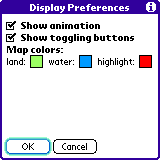 To change display preferences, call the Options=>Display Preferences... menu command in the main setup screen.
To change display preferences, call the Options=>Display Preferences... menu command in the main setup screen.
- Show animation - animation occurs during a phone call: when toggling viewed items (e.g. country map=>local map), toggling item type (e.g. flag=>map), and when expanding a map.
- Show toggling buttons - these buttons are used during a phone call to toggle viewed items and item types. Even if they are hidden, you may still toggle items with hardware buttons: Q/A and Y/U/I/O/P.
- Map colors - you may customize the colors on maps displayed by TopAreaCodes during a phone call.
| |
|
 |
|
| Dial preferences |  |
|
|
|
 |
|
 |
| |
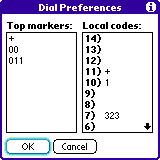 To change dial preferences, call the Options=>Dial Preferences... menu command in the main setup screen.
To change dial preferences, call the Options=>Dial Preferences... menu command in the main setup screen.
These preferences control the way dialed numbers are detected and decoded by TopAreaCodes to find the relevant information. They differ in different countries. By default, TopAreaCodes is configured to operate in North America, but most of its functions will work anywhere in the world.
- Top markers - define all possible wide-range calling code prefixes. All international calls begin with one of these markers.
- Local codes - if a dialed number does not begin with any of the top markers, the appropriate local code is added. The numbers 14 down to 1 stand for the number of digits the dialed number must have for a given local code to be used. In general, this local codes list should start with one of the top markers (+ in the screenshot to the right), followed by the local country code (1 for the USA), and the local area code (323 stands for California in this example).
| |
|
 |
|
| Find Area by Code |  |
|
|
|
 |
|
 |
| |
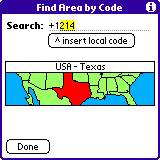 When you know a code and would like to receive detailed information about it, call the Tools=>Find Area by Code... menu command in the main setup screen.
When you know a code and would like to receive detailed information about it, call the Tools=>Find Area by Code... menu command in the main setup screen.
Enter the area code in the Search field as if you were dialing a number, and the complete information on this area will be displayed.
The area code must begin with one of the top markers (e.g. +). You may tap the ^ insert local code button to have it inserted for you.
| |
|
 |
|
| Find Code by Area |  |
|
|
|
 |
|
 |
| |
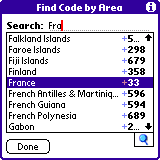 When you know the name of an area and would like to know its code, select a text database containing that area and call the Tools=>Find Code by Area... menu command in the main setup screen.
When you know the name of an area and would like to know its code, select a text database containing that area and call the Tools=>Find Code by Area... menu command in the main setup screen.
Start typing the area name in the Search field and its area code will be displayed. If a given area has more than one code, the  symbol will be shown. Tap the symbol will be shown. Tap the  button to see details of the selected area. These include the complete list of area codes as well as the map, flag and seal (if the appropriate databases are installed). button to see details of the selected area. These include the complete list of area codes as well as the map, flag and seal (if the appropriate databases are installed).
| |
|
 |
|
| Answering an incoming call |  |
|
|
|
 |
|
 |
| |
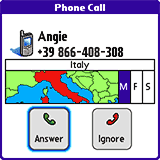 When someone calls you, the information about his area is immediately displayed on the screen. You will see the country or state name, map, flag, and/or seal (coat of arms).
When someone calls you, the information about his area is immediately displayed on the screen. You will see the country or state name, map, flag, and/or seal (coat of arms).
TopAreaCodes must be active and appropriate databases must be installed and enabled:
- To get information on international calls, you must have World databases installed.
- To get information on calls from the USA, you must have USA databases installed.
Note: no information is displayed for callers with an assigned photograph (you will see the photograph instead).
| |
|
 |
|
| Outgoing and active calls |  |
|
|
|
 |
|
 |
| |
 When talking to someone on the phone, the information about his area is displayed on the screen all the time. You will see the country or state name, the map, the flag, and/or the seal (coat of arms).
When talking to someone on the phone, the information about his area is displayed on the screen all the time. You will see the country or state name, the map, the flag, and/or the seal (coat of arms).
TopAreaCodes must be active and appropriate databases must be installed and enabled:
- To get information on international calls, you must have World databases installed.
- To get information on calls from the USA, you must have USA databases installed.
Note: no information is displayed during a conference call (you will see the number and the name of the other caller instead).
| |
|
 |
|
| Toggling displayed items |  |
|
|
|
 |
|
 |
| |
During a phone call, only one graphical item may be displayed at a time. Initially, this will be the topmost item in the databases list in the main TopAreaCodes setup screen. To see other items, do one of the following:
- Tap the
 and and  buttons to toggle viewed items (e.g. country map=>local map). buttons to toggle viewed items (e.g. country map=>local map).
Additionally, the Q and A hard buttons correspond to these on-screen buttons.
- Tap one of the
 buttons to toggle item type (e.g. flag=>map). buttons to toggle item type (e.g. flag=>map).
Additionally, the I, O and P hard buttons correspond to these on-screen buttons.
| |
|
 |
|
| Expanding area map |  |
|
|
|
 |
|
 |
| |
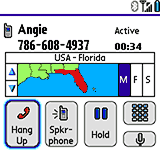 Normally, the displayed area map is really small and clipped.
Normally, the displayed area map is really small and clipped.
To expand the map, simply tap it and hold. Alternatively, you may use the Shift hard button.
| |
|
 |
|
| TopAreaCodes vs. TreoAreaCodes |  |
|
|
|
 |
|
 |
| |
|
In March 2008 RNS:: TreoAreaCodes was renamed to RNS:: TopAreaCodes.
The change was necessary after Palm released a new Treo smartphone (Centro) under a non-Treo name.
| |
|
 |
|
| My question is not listed in this FAQ! |  |
|
|
|
 |
|
 |
| |
|
Use TopAreaCodes Forum - a message board - the preferred way to ask your questions. Everyone can benefit from the questions and answers posted there...
| |
|
Palm, Treo, and Centro are trademarks or registered trademarks of Palm, Inc.
Copyright © 2026 RNS::
| |